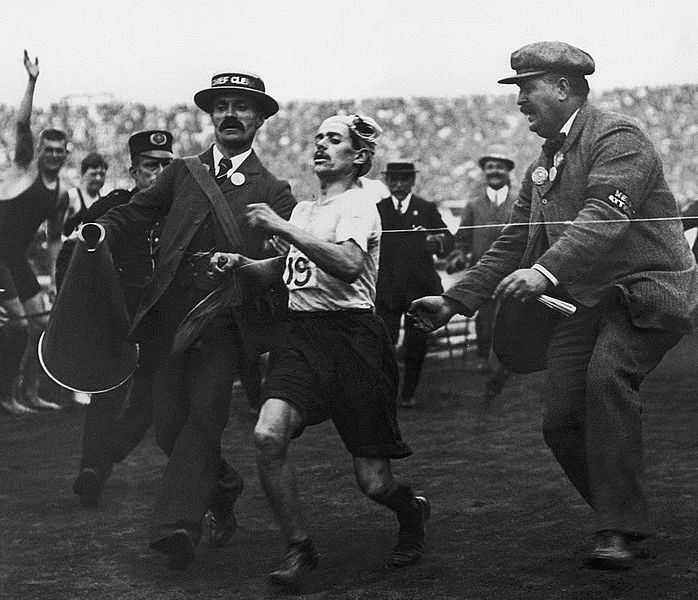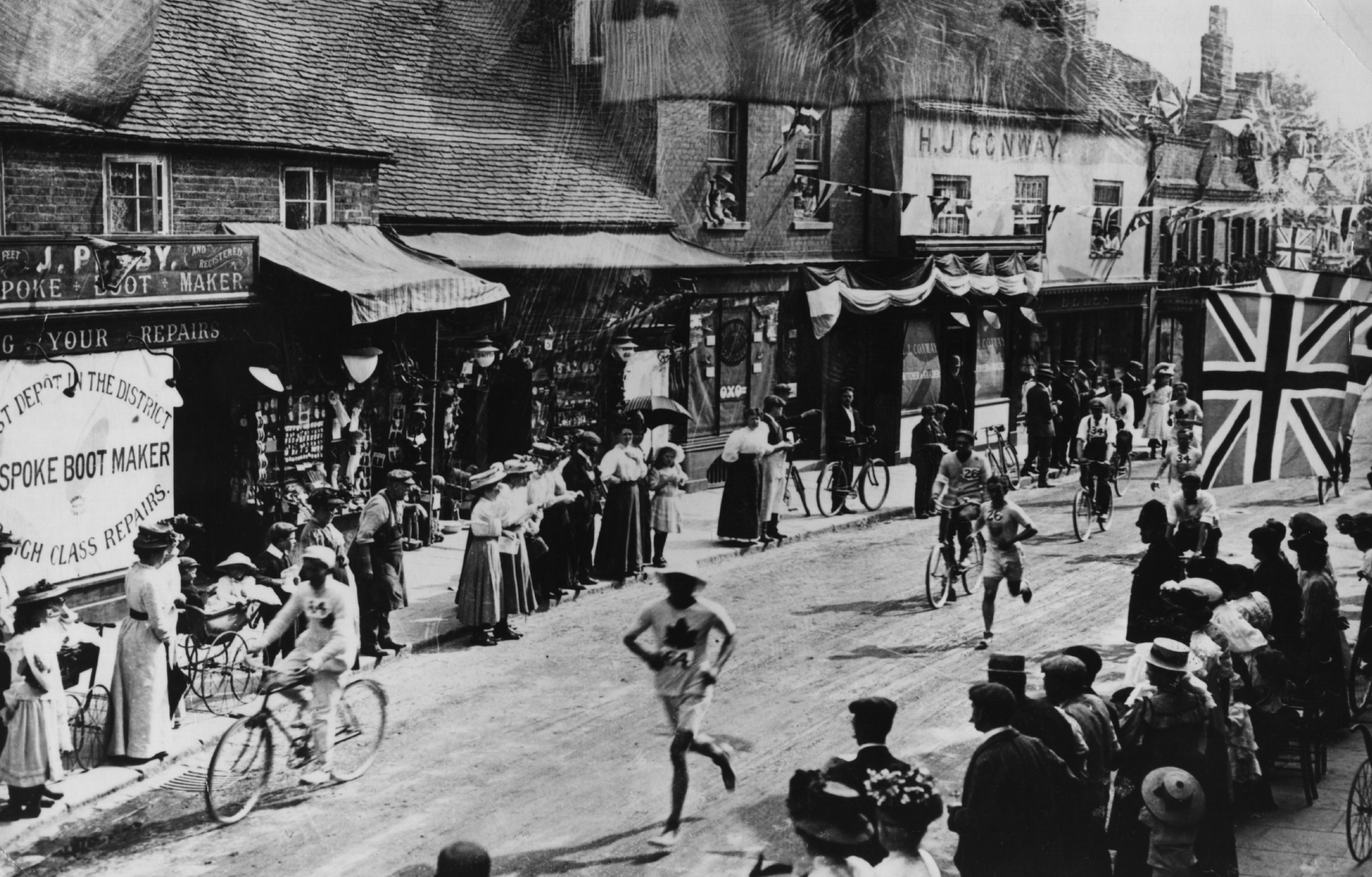Remembering When Runners Drank Champagne as an Energy Drink
At the 1908 Marathon in London, athletes hit the bottle mid-race.

On July 24, 1908, the London Olympic Marathon went down in history as one hell of a race. Summer heat had plagued the city, and a newly resurfaced track stretched hard as rock under the runners’ feet. At the last minute, the course was extended nearly two miles, forever setting the official marathon length to an arbitrary 26 miles and 385 yards.
So much drama unraveled under these harsh conditions that Sir Arthur Conan Doyle (of Sherlock Holmes fame) was inspired to write a recap for The Daily Mail. “I caught a glimpse of the haggard, yellow face, the glazed, expressionless eyes, the long, black hair streaked across the brow,” he wrote of the eventual winner. Fifty-five runners started off from Windsor Castle, but only 27 made it to the finish line. The majority of runners quit before the halfway mark.
For a badly needed boost, a number of competitors turned to unlikely, but common-at-the-time sources: brandy, glasses of bubbly, and strychnine (best known now as rat poison).
Wild as it may seem today, people once believed alcohol and strychnine cocktails were performance enhancers. The drinks were doled out like Gatorade or energy gels to endurance athletes. According to Dr. Matthew Barnes, Senior Lecturer and Deputy Head of the School of Sport, Exercise, and Nutrition at New Zealand’s Massey University, plying athletes with alcohol started in Ancient Greece and Imperial China.
Modern use of alcohol in sports can be traced back to the competitive foot races of the 19th century. Essentially very long walks of dozens or hundreds of miles, these events captivated Great Britain. Contending “pedestrians” were advised to down lots of champagne during competition. Years later, marathoners were often given boozy boosts by trainers or assistants who followed their runners in cars or on bicycles.

Common substances included various alcohols and dangerous drugs—from strychnine to heroin or cocaine—which were meant to mask pain, increase aggressiveness, or gain a quick energy boost. Trainers often had their own secret cocktails, and people didn’t stop using heroin and cocaine as performance-enhancing additives until the 1920s, when the drugs became prescription-only substances. And athletes boozed during competition all the way into the ‘70s and ‘80s.
Alcohol as a whole was celebrated for its stimulative effects and high sugar (energy) content. Champagne was a favorite thanks to its supposedly rejuvenating effervescence. And, since strychnine’s use as a pesticide had not yet been discovered, low doses were believed to reinvigorate tired sportsmen.
At the time, it seemed to work. In 1896, at the inaugural modern Olympic Games, Greek marathon runner Spiridon Louis famously knocked back a glass of cognac with six miles left to go in the race. Refreshed, he went on to win the gold. The 1904 St. Louis Olympic Marathon runners battled sweltering 95-degree heat and borderline inhumane track conditions. Throughout his victorious run, Thomas Hicks regularly sipped near-deadly cocktails of strychnine, brandy, and sulfate in egg whites. In 1908, the winner of the Chicago Marathon, janitor-turned-runner Albert Corey, credited his win a steady supply of champagne.
At the 1908 Olympic Marathon, at least a handful of runners imbibed alcohol or strychnine cocktails during the race—including the first four to cross the finish line.
Thanks to his recent record-breaking win at the Boston Marathon, Canadian runner Tom Longboat was the favorite at the London Games. Unfortunately, he never finished. After plodding his way into second place, the 20-year-old runner fell victim to the brutal heat. At mile 17, likely dehydrated and exhausted, Longboat slowed to a walk. Searching for energy, he turned to champagne. Two miles later, he collapsed and was out of the race.
South Africa’s Charles Hefferon also imbibed. Unlike most of the runners, he seemed to cope well with the inhospitable conditions. By mile 15, Hefferon had a two-minute lead. Nine miles later, he had doubled his lead time, leaving the gold medal within a few minutes’ reach. Or so it seemed. But two miles from the finish line, Hefferon “accepted a draught of champagne,” an act he later admitted cost him the race. The drink caused intense stomach pains, and Hefferon was forced to slow and watched two runners pass. Once a shoe-in for the gold, Hefferon finished third.

At the finish line, Arthur Conan Doyle and 80,000 spectators waited for an “exultant victor.” Instead they spied Italian pastry chef Dorando Pietri, a “little man, with red running-drawers” (in Conan Doyle’s words) who “reeled as he entered and faced the roar of the applause.” In the last quarter mile alone, an exhausted and dazed Pietri had collapsed five times, had run in the wrong direction, and even had the area over his heart massaged by concerned medics.
In a now-famous photograph of Pietri crossing the finish line, a hollowed cork wedge can be seen in his hand. Clenching cork wedges helped endurance runners relieve strain on their hands and fingers, but when hollowed-out, they acted as vessels for wine, brandy, and other questionable energy drinks. In the end, concern for Pietri’s life resulted in the runner being supported across the finish line by a doctor, causing his eventual disqualification and a redistribution of the race’s medals. Some attribute Pietri’s physical downfall to being drunk, while others believe both he and Longboat were subjected to strychnine poisoning.
Not all of the boozed runners fared poorly. De facto gold medalist Johnny Hayes admitted to an energizing gargle of brandy during the race, and bronze medalist Joseph Forshaw also turned to brandy in order to treat a stubborn side stitch. He claimed he “felt fine” after, and was able to carry on in the final leg. Around that same time, it was believed that dehydration was better treated with wine than water. In fact, the 1924 Paris Games infamously stocked its rehydration stations with glasses of wine.
Thanks to later studies on the effects of alcohol on muscle groups and hydration, trainers no longer offer athletes strychnine cocktails or glasses of bubbly. However, alcohol is still an option for runners looking to enhance a race along other dimensions. At the Marathon de Médoc in French wine country, 23 different glasses of wine (and other gastronomic goodies) await runners along the 26.2-mile route. But thankfully, no one believes it will actually help them win.
Gastro Obscura covers the world’s most wondrous food and drink.
Sign up for our regular newsletter.




























Follow us on Twitter to get the latest on the world's hidden wonders.
Like us on Facebook to get the latest on the world's hidden wonders.
Follow us on Twitter Like us on Facebook